Importance and Value of Operations Management in John Lewis
VerifiedAdded on 2023/01/17
|12
|3876
|70
AI Summary
This document discusses the key approaches to operations management in John Lewis and the role of leaders and managers in implementing these approaches. It also highlights the importance and value of operations management in the company.
Contribute Materials
Your contribution can guide someone’s learning journey. Share your
documents today.
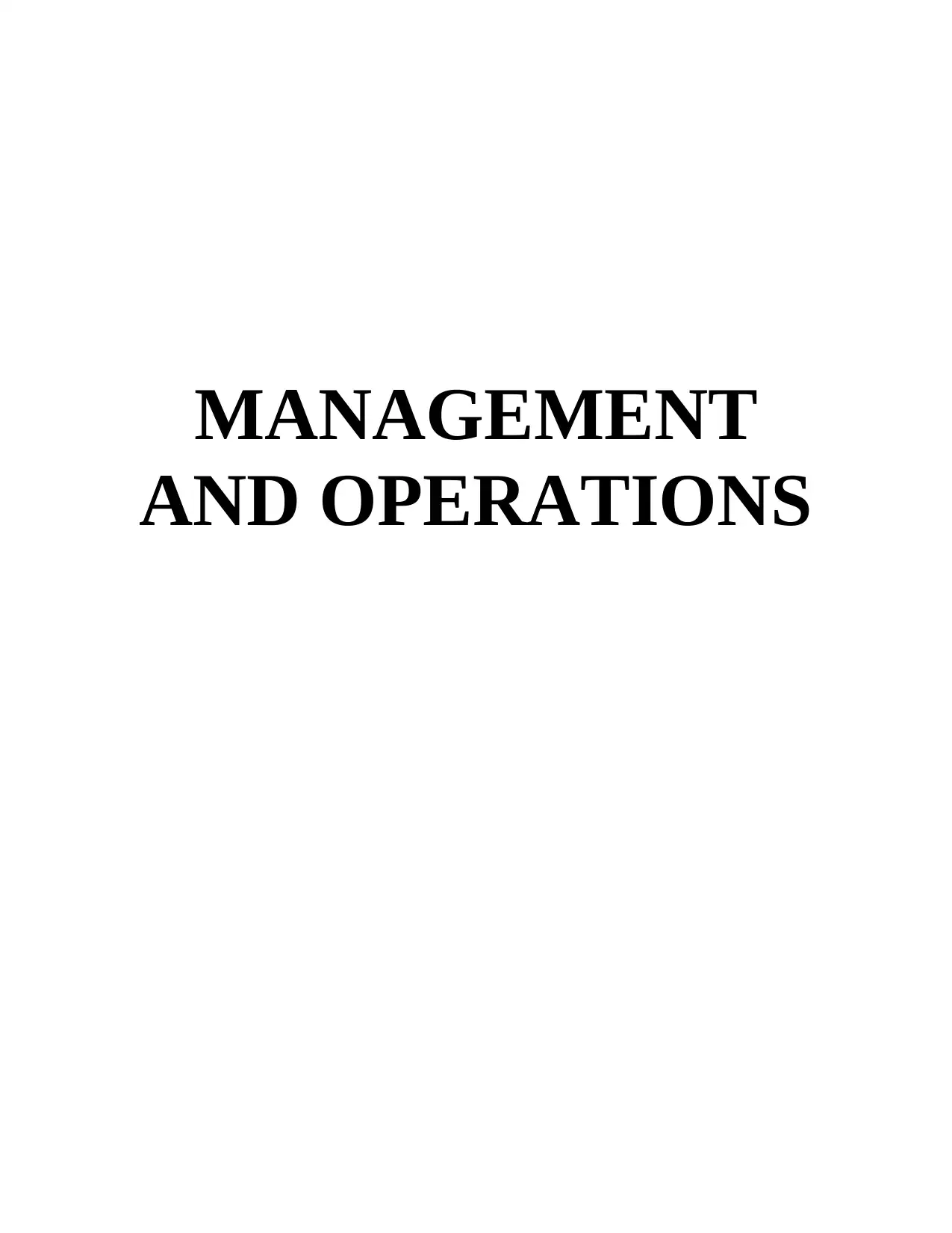
MANAGEMENT
AND OPERATIONS
AND OPERATIONS
Secure Best Marks with AI Grader
Need help grading? Try our AI Grader for instant feedback on your assignments.
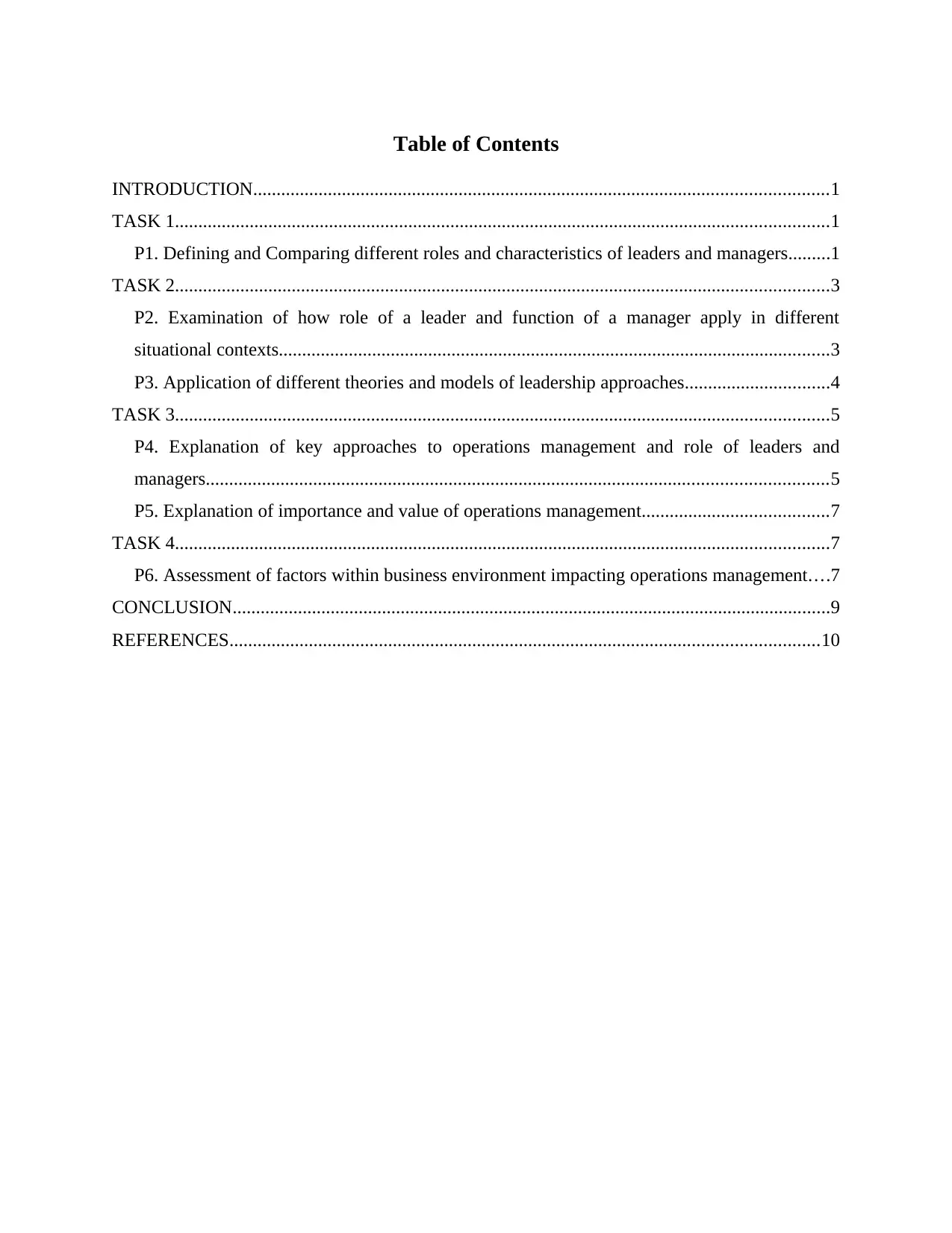
Table of Contents
INTRODUCTION...........................................................................................................................1
TASK 1............................................................................................................................................1
P1. Defining and Comparing different roles and characteristics of leaders and managers.........1
TASK 2............................................................................................................................................3
P2. Examination of how role of a leader and function of a manager apply in different
situational contexts......................................................................................................................3
P3. Application of different theories and models of leadership approaches...............................4
TASK 3............................................................................................................................................5
P4. Explanation of key approaches to operations management and role of leaders and
managers.....................................................................................................................................5
P5. Explanation of importance and value of operations management........................................7
TASK 4............................................................................................................................................7
P6. Assessment of factors within business environment impacting operations management....7
CONCLUSION................................................................................................................................9
REFERENCES..............................................................................................................................10
INTRODUCTION...........................................................................................................................1
TASK 1............................................................................................................................................1
P1. Defining and Comparing different roles and characteristics of leaders and managers.........1
TASK 2............................................................................................................................................3
P2. Examination of how role of a leader and function of a manager apply in different
situational contexts......................................................................................................................3
P3. Application of different theories and models of leadership approaches...............................4
TASK 3............................................................................................................................................5
P4. Explanation of key approaches to operations management and role of leaders and
managers.....................................................................................................................................5
P5. Explanation of importance and value of operations management........................................7
TASK 4............................................................................................................................................7
P6. Assessment of factors within business environment impacting operations management....7
CONCLUSION................................................................................................................................9
REFERENCES..............................................................................................................................10
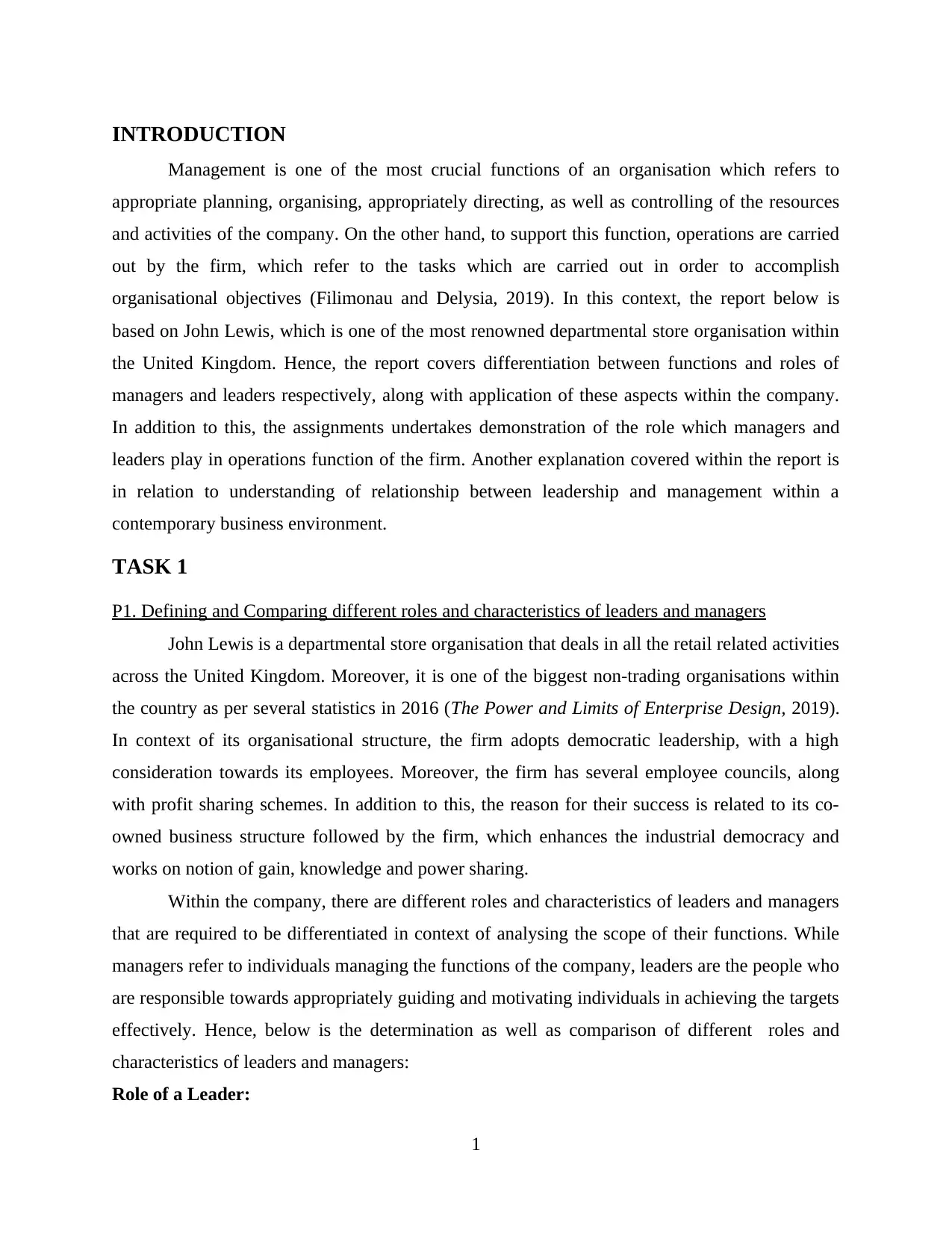
INTRODUCTION
Management is one of the most crucial functions of an organisation which refers to
appropriate planning, organising, appropriately directing, as well as controlling of the resources
and activities of the company. On the other hand, to support this function, operations are carried
out by the firm, which refer to the tasks which are carried out in order to accomplish
organisational objectives (Filimonau and Delysia, 2019). In this context, the report below is
based on John Lewis, which is one of the most renowned departmental store organisation within
the United Kingdom. Hence, the report covers differentiation between functions and roles of
managers and leaders respectively, along with application of these aspects within the company.
In addition to this, the assignments undertakes demonstration of the role which managers and
leaders play in operations function of the firm. Another explanation covered within the report is
in relation to understanding of relationship between leadership and management within a
contemporary business environment.
TASK 1
P1. Defining and Comparing different roles and characteristics of leaders and managers
John Lewis is a departmental store organisation that deals in all the retail related activities
across the United Kingdom. Moreover, it is one of the biggest non-trading organisations within
the country as per several statistics in 2016 (The Power and Limits of Enterprise Design, 2019).
In context of its organisational structure, the firm adopts democratic leadership, with a high
consideration towards its employees. Moreover, the firm has several employee councils, along
with profit sharing schemes. In addition to this, the reason for their success is related to its co-
owned business structure followed by the firm, which enhances the industrial democracy and
works on notion of gain, knowledge and power sharing.
Within the company, there are different roles and characteristics of leaders and managers
that are required to be differentiated in context of analysing the scope of their functions. While
managers refer to individuals managing the functions of the company, leaders are the people who
are responsible towards appropriately guiding and motivating individuals in achieving the targets
effectively. Hence, below is the determination as well as comparison of different roles and
characteristics of leaders and managers:
Role of a Leader:
1
Management is one of the most crucial functions of an organisation which refers to
appropriate planning, organising, appropriately directing, as well as controlling of the resources
and activities of the company. On the other hand, to support this function, operations are carried
out by the firm, which refer to the tasks which are carried out in order to accomplish
organisational objectives (Filimonau and Delysia, 2019). In this context, the report below is
based on John Lewis, which is one of the most renowned departmental store organisation within
the United Kingdom. Hence, the report covers differentiation between functions and roles of
managers and leaders respectively, along with application of these aspects within the company.
In addition to this, the assignments undertakes demonstration of the role which managers and
leaders play in operations function of the firm. Another explanation covered within the report is
in relation to understanding of relationship between leadership and management within a
contemporary business environment.
TASK 1
P1. Defining and Comparing different roles and characteristics of leaders and managers
John Lewis is a departmental store organisation that deals in all the retail related activities
across the United Kingdom. Moreover, it is one of the biggest non-trading organisations within
the country as per several statistics in 2016 (The Power and Limits of Enterprise Design, 2019).
In context of its organisational structure, the firm adopts democratic leadership, with a high
consideration towards its employees. Moreover, the firm has several employee councils, along
with profit sharing schemes. In addition to this, the reason for their success is related to its co-
owned business structure followed by the firm, which enhances the industrial democracy and
works on notion of gain, knowledge and power sharing.
Within the company, there are different roles and characteristics of leaders and managers
that are required to be differentiated in context of analysing the scope of their functions. While
managers refer to individuals managing the functions of the company, leaders are the people who
are responsible towards appropriately guiding and motivating individuals in achieving the targets
effectively. Hence, below is the determination as well as comparison of different roles and
characteristics of leaders and managers:
Role of a Leader:
1
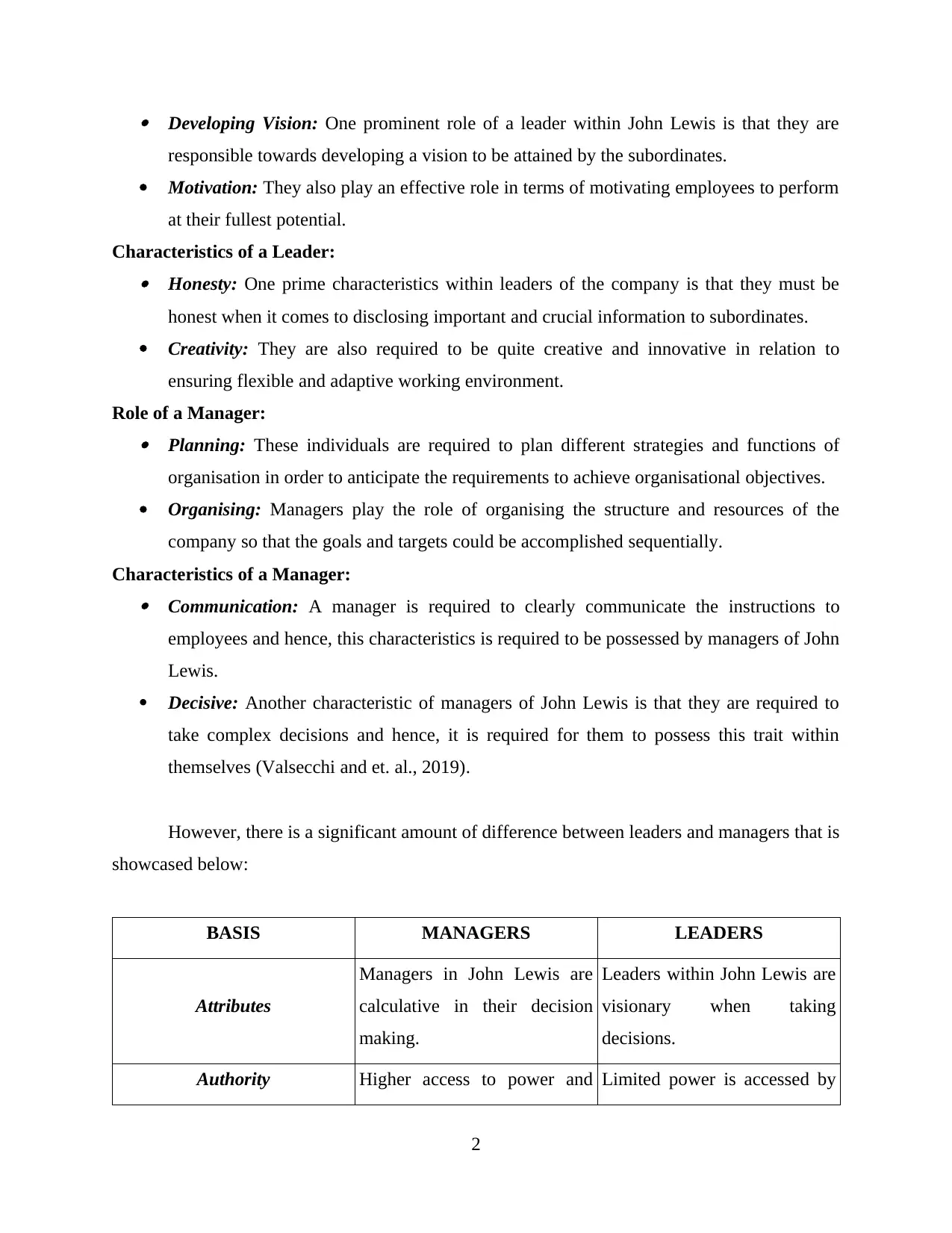
Developing Vision: One prominent role of a leader within John Lewis is that they are
responsible towards developing a vision to be attained by the subordinates.
Motivation: They also play an effective role in terms of motivating employees to perform
at their fullest potential.
Characteristics of a Leader: Honesty: One prime characteristics within leaders of the company is that they must be
honest when it comes to disclosing important and crucial information to subordinates.
Creativity: They are also required to be quite creative and innovative in relation to
ensuring flexible and adaptive working environment.
Role of a Manager: Planning: These individuals are required to plan different strategies and functions of
organisation in order to anticipate the requirements to achieve organisational objectives.
Organising: Managers play the role of organising the structure and resources of the
company so that the goals and targets could be accomplished sequentially.
Characteristics of a Manager: Communication: A manager is required to clearly communicate the instructions to
employees and hence, this characteristics is required to be possessed by managers of John
Lewis.
Decisive: Another characteristic of managers of John Lewis is that they are required to
take complex decisions and hence, it is required for them to possess this trait within
themselves (Valsecchi and et. al., 2019).
However, there is a significant amount of difference between leaders and managers that is
showcased below:
BASIS MANAGERS LEADERS
Attributes
Managers in John Lewis are
calculative in their decision
making.
Leaders within John Lewis are
visionary when taking
decisions.
Authority Higher access to power and Limited power is accessed by
2
responsible towards developing a vision to be attained by the subordinates.
Motivation: They also play an effective role in terms of motivating employees to perform
at their fullest potential.
Characteristics of a Leader: Honesty: One prime characteristics within leaders of the company is that they must be
honest when it comes to disclosing important and crucial information to subordinates.
Creativity: They are also required to be quite creative and innovative in relation to
ensuring flexible and adaptive working environment.
Role of a Manager: Planning: These individuals are required to plan different strategies and functions of
organisation in order to anticipate the requirements to achieve organisational objectives.
Organising: Managers play the role of organising the structure and resources of the
company so that the goals and targets could be accomplished sequentially.
Characteristics of a Manager: Communication: A manager is required to clearly communicate the instructions to
employees and hence, this characteristics is required to be possessed by managers of John
Lewis.
Decisive: Another characteristic of managers of John Lewis is that they are required to
take complex decisions and hence, it is required for them to possess this trait within
themselves (Valsecchi and et. al., 2019).
However, there is a significant amount of difference between leaders and managers that is
showcased below:
BASIS MANAGERS LEADERS
Attributes
Managers in John Lewis are
calculative in their decision
making.
Leaders within John Lewis are
visionary when taking
decisions.
Authority Higher access to power and Limited power is accessed by
2
Secure Best Marks with AI Grader
Need help grading? Try our AI Grader for instant feedback on your assignments.
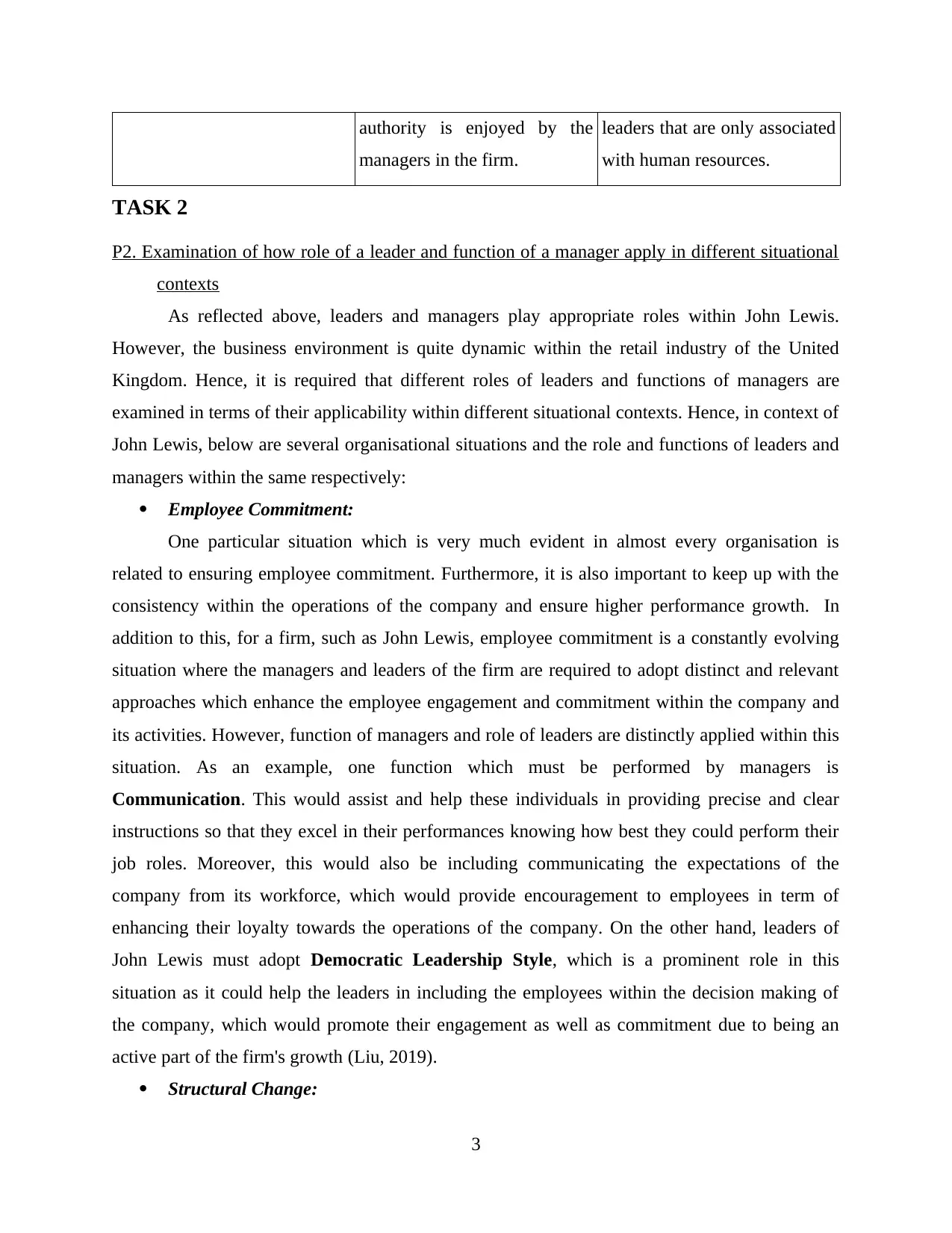
authority is enjoyed by the
managers in the firm.
leaders that are only associated
with human resources.
TASK 2
P2. Examination of how role of a leader and function of a manager apply in different situational
contexts
As reflected above, leaders and managers play appropriate roles within John Lewis.
However, the business environment is quite dynamic within the retail industry of the United
Kingdom. Hence, it is required that different roles of leaders and functions of managers are
examined in terms of their applicability within different situational contexts. Hence, in context of
John Lewis, below are several organisational situations and the role and functions of leaders and
managers within the same respectively:
Employee Commitment:
One particular situation which is very much evident in almost every organisation is
related to ensuring employee commitment. Furthermore, it is also important to keep up with the
consistency within the operations of the company and ensure higher performance growth. In
addition to this, for a firm, such as John Lewis, employee commitment is a constantly evolving
situation where the managers and leaders of the firm are required to adopt distinct and relevant
approaches which enhance the employee engagement and commitment within the company and
its activities. However, function of managers and role of leaders are distinctly applied within this
situation. As an example, one function which must be performed by managers is
Communication. This would assist and help these individuals in providing precise and clear
instructions so that they excel in their performances knowing how best they could perform their
job roles. Moreover, this would also be including communicating the expectations of the
company from its workforce, which would provide encouragement to employees in term of
enhancing their loyalty towards the operations of the company. On the other hand, leaders of
John Lewis must adopt Democratic Leadership Style, which is a prominent role in this
situation as it could help the leaders in including the employees within the decision making of
the company, which would promote their engagement as well as commitment due to being an
active part of the firm's growth (Liu, 2019).
Structural Change:
3
managers in the firm.
leaders that are only associated
with human resources.
TASK 2
P2. Examination of how role of a leader and function of a manager apply in different situational
contexts
As reflected above, leaders and managers play appropriate roles within John Lewis.
However, the business environment is quite dynamic within the retail industry of the United
Kingdom. Hence, it is required that different roles of leaders and functions of managers are
examined in terms of their applicability within different situational contexts. Hence, in context of
John Lewis, below are several organisational situations and the role and functions of leaders and
managers within the same respectively:
Employee Commitment:
One particular situation which is very much evident in almost every organisation is
related to ensuring employee commitment. Furthermore, it is also important to keep up with the
consistency within the operations of the company and ensure higher performance growth. In
addition to this, for a firm, such as John Lewis, employee commitment is a constantly evolving
situation where the managers and leaders of the firm are required to adopt distinct and relevant
approaches which enhance the employee engagement and commitment within the company and
its activities. However, function of managers and role of leaders are distinctly applied within this
situation. As an example, one function which must be performed by managers is
Communication. This would assist and help these individuals in providing precise and clear
instructions so that they excel in their performances knowing how best they could perform their
job roles. Moreover, this would also be including communicating the expectations of the
company from its workforce, which would provide encouragement to employees in term of
enhancing their loyalty towards the operations of the company. On the other hand, leaders of
John Lewis must adopt Democratic Leadership Style, which is a prominent role in this
situation as it could help the leaders in including the employees within the decision making of
the company, which would promote their engagement as well as commitment due to being an
active part of the firm's growth (Liu, 2019).
Structural Change:
3
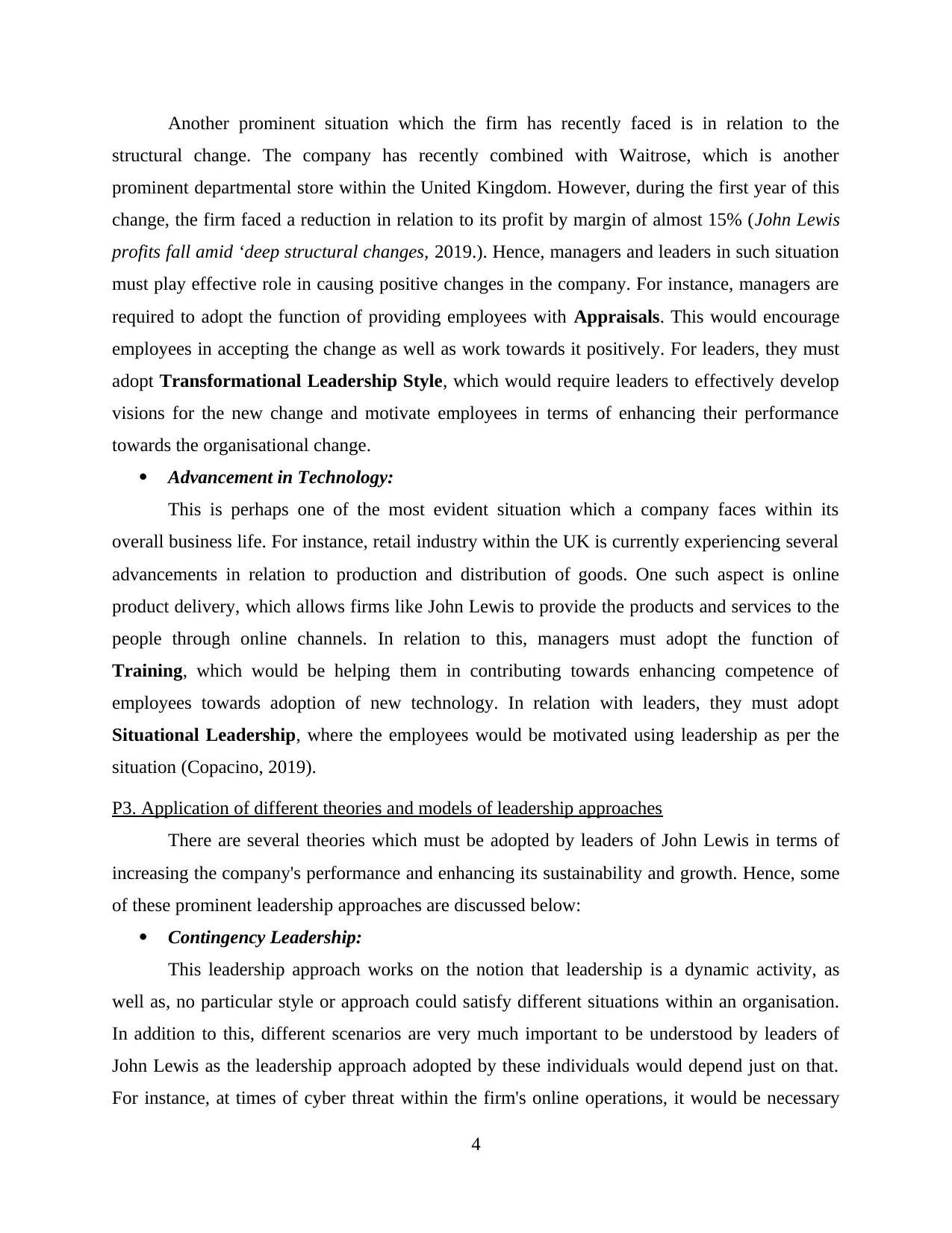
Another prominent situation which the firm has recently faced is in relation to the
structural change. The company has recently combined with Waitrose, which is another
prominent departmental store within the United Kingdom. However, during the first year of this
change, the firm faced a reduction in relation to its profit by margin of almost 15% (John Lewis
profits fall amid ‘deep structural changes, 2019.). Hence, managers and leaders in such situation
must play effective role in causing positive changes in the company. For instance, managers are
required to adopt the function of providing employees with Appraisals. This would encourage
employees in accepting the change as well as work towards it positively. For leaders, they must
adopt Transformational Leadership Style, which would require leaders to effectively develop
visions for the new change and motivate employees in terms of enhancing their performance
towards the organisational change.
Advancement in Technology:
This is perhaps one of the most evident situation which a company faces within its
overall business life. For instance, retail industry within the UK is currently experiencing several
advancements in relation to production and distribution of goods. One such aspect is online
product delivery, which allows firms like John Lewis to provide the products and services to the
people through online channels. In relation to this, managers must adopt the function of
Training, which would be helping them in contributing towards enhancing competence of
employees towards adoption of new technology. In relation with leaders, they must adopt
Situational Leadership, where the employees would be motivated using leadership as per the
situation (Copacino, 2019).
P3. Application of different theories and models of leadership approaches
There are several theories which must be adopted by leaders of John Lewis in terms of
increasing the company's performance and enhancing its sustainability and growth. Hence, some
of these prominent leadership approaches are discussed below:
Contingency Leadership:
This leadership approach works on the notion that leadership is a dynamic activity, as
well as, no particular style or approach could satisfy different situations within an organisation.
In addition to this, different scenarios are very much important to be understood by leaders of
John Lewis as the leadership approach adopted by these individuals would depend just on that.
For instance, at times of cyber threat within the firm's online operations, it would be necessary
4
structural change. The company has recently combined with Waitrose, which is another
prominent departmental store within the United Kingdom. However, during the first year of this
change, the firm faced a reduction in relation to its profit by margin of almost 15% (John Lewis
profits fall amid ‘deep structural changes, 2019.). Hence, managers and leaders in such situation
must play effective role in causing positive changes in the company. For instance, managers are
required to adopt the function of providing employees with Appraisals. This would encourage
employees in accepting the change as well as work towards it positively. For leaders, they must
adopt Transformational Leadership Style, which would require leaders to effectively develop
visions for the new change and motivate employees in terms of enhancing their performance
towards the organisational change.
Advancement in Technology:
This is perhaps one of the most evident situation which a company faces within its
overall business life. For instance, retail industry within the UK is currently experiencing several
advancements in relation to production and distribution of goods. One such aspect is online
product delivery, which allows firms like John Lewis to provide the products and services to the
people through online channels. In relation to this, managers must adopt the function of
Training, which would be helping them in contributing towards enhancing competence of
employees towards adoption of new technology. In relation with leaders, they must adopt
Situational Leadership, where the employees would be motivated using leadership as per the
situation (Copacino, 2019).
P3. Application of different theories and models of leadership approaches
There are several theories which must be adopted by leaders of John Lewis in terms of
increasing the company's performance and enhancing its sustainability and growth. Hence, some
of these prominent leadership approaches are discussed below:
Contingency Leadership:
This leadership approach works on the notion that leadership is a dynamic activity, as
well as, no particular style or approach could satisfy different situations within an organisation.
In addition to this, different scenarios are very much important to be understood by leaders of
John Lewis as the leadership approach adopted by these individuals would depend just on that.
For instance, at times of cyber threat within the firm's online operations, it would be necessary
4
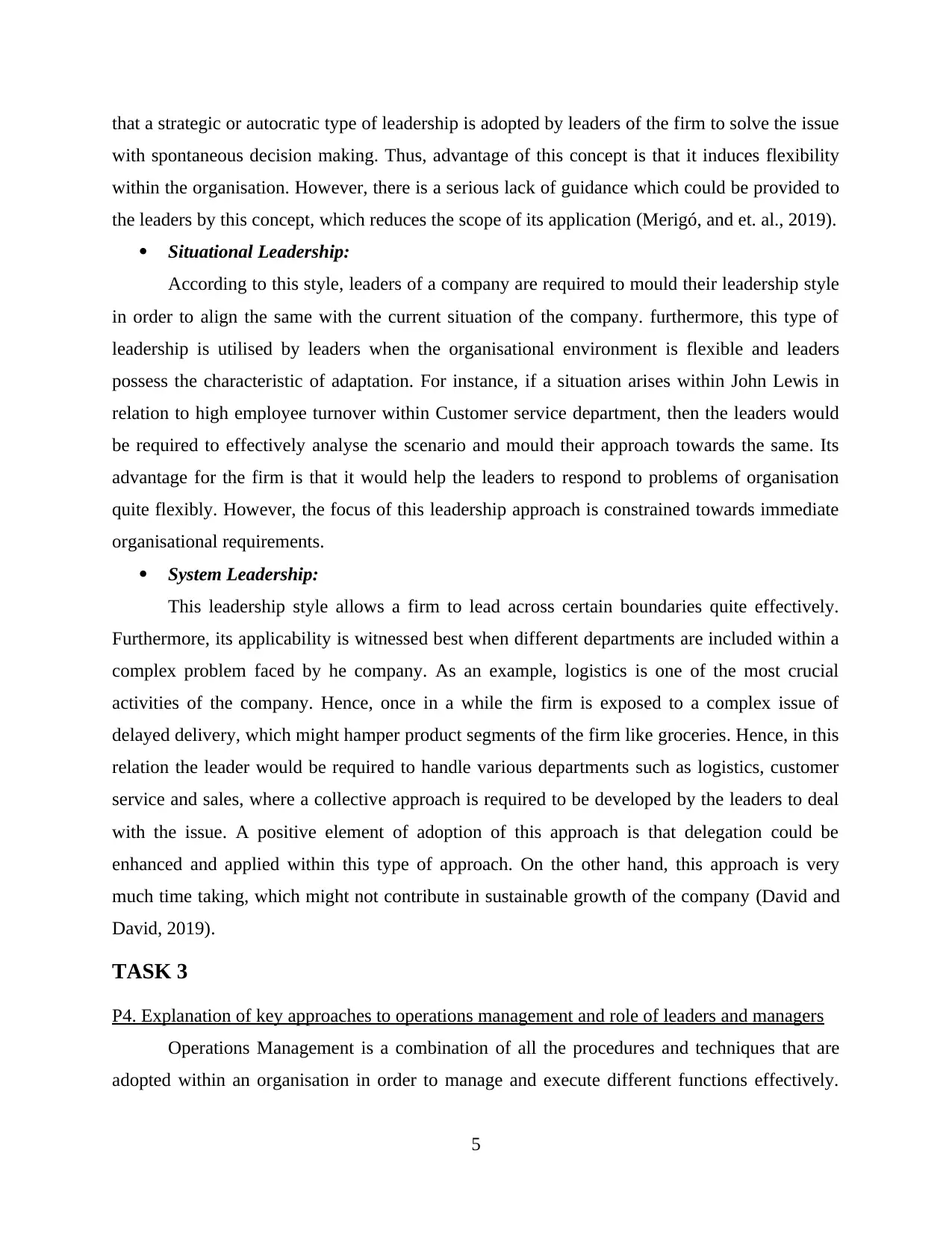
that a strategic or autocratic type of leadership is adopted by leaders of the firm to solve the issue
with spontaneous decision making. Thus, advantage of this concept is that it induces flexibility
within the organisation. However, there is a serious lack of guidance which could be provided to
the leaders by this concept, which reduces the scope of its application (Merigó, and et. al., 2019).
Situational Leadership:
According to this style, leaders of a company are required to mould their leadership style
in order to align the same with the current situation of the company. furthermore, this type of
leadership is utilised by leaders when the organisational environment is flexible and leaders
possess the characteristic of adaptation. For instance, if a situation arises within John Lewis in
relation to high employee turnover within Customer service department, then the leaders would
be required to effectively analyse the scenario and mould their approach towards the same. Its
advantage for the firm is that it would help the leaders to respond to problems of organisation
quite flexibly. However, the focus of this leadership approach is constrained towards immediate
organisational requirements.
System Leadership:
This leadership style allows a firm to lead across certain boundaries quite effectively.
Furthermore, its applicability is witnessed best when different departments are included within a
complex problem faced by he company. As an example, logistics is one of the most crucial
activities of the company. Hence, once in a while the firm is exposed to a complex issue of
delayed delivery, which might hamper product segments of the firm like groceries. Hence, in this
relation the leader would be required to handle various departments such as logistics, customer
service and sales, where a collective approach is required to be developed by the leaders to deal
with the issue. A positive element of adoption of this approach is that delegation could be
enhanced and applied within this type of approach. On the other hand, this approach is very
much time taking, which might not contribute in sustainable growth of the company (David and
David, 2019).
TASK 3
P4. Explanation of key approaches to operations management and role of leaders and managers
Operations Management is a combination of all the procedures and techniques that are
adopted within an organisation in order to manage and execute different functions effectively.
5
with spontaneous decision making. Thus, advantage of this concept is that it induces flexibility
within the organisation. However, there is a serious lack of guidance which could be provided to
the leaders by this concept, which reduces the scope of its application (Merigó, and et. al., 2019).
Situational Leadership:
According to this style, leaders of a company are required to mould their leadership style
in order to align the same with the current situation of the company. furthermore, this type of
leadership is utilised by leaders when the organisational environment is flexible and leaders
possess the characteristic of adaptation. For instance, if a situation arises within John Lewis in
relation to high employee turnover within Customer service department, then the leaders would
be required to effectively analyse the scenario and mould their approach towards the same. Its
advantage for the firm is that it would help the leaders to respond to problems of organisation
quite flexibly. However, the focus of this leadership approach is constrained towards immediate
organisational requirements.
System Leadership:
This leadership style allows a firm to lead across certain boundaries quite effectively.
Furthermore, its applicability is witnessed best when different departments are included within a
complex problem faced by he company. As an example, logistics is one of the most crucial
activities of the company. Hence, once in a while the firm is exposed to a complex issue of
delayed delivery, which might hamper product segments of the firm like groceries. Hence, in this
relation the leader would be required to handle various departments such as logistics, customer
service and sales, where a collective approach is required to be developed by the leaders to deal
with the issue. A positive element of adoption of this approach is that delegation could be
enhanced and applied within this type of approach. On the other hand, this approach is very
much time taking, which might not contribute in sustainable growth of the company (David and
David, 2019).
TASK 3
P4. Explanation of key approaches to operations management and role of leaders and managers
Operations Management is a combination of all the procedures and techniques that are
adopted within an organisation in order to manage and execute different functions effectively.
5
Paraphrase This Document
Need a fresh take? Get an instant paraphrase of this document with our AI Paraphraser
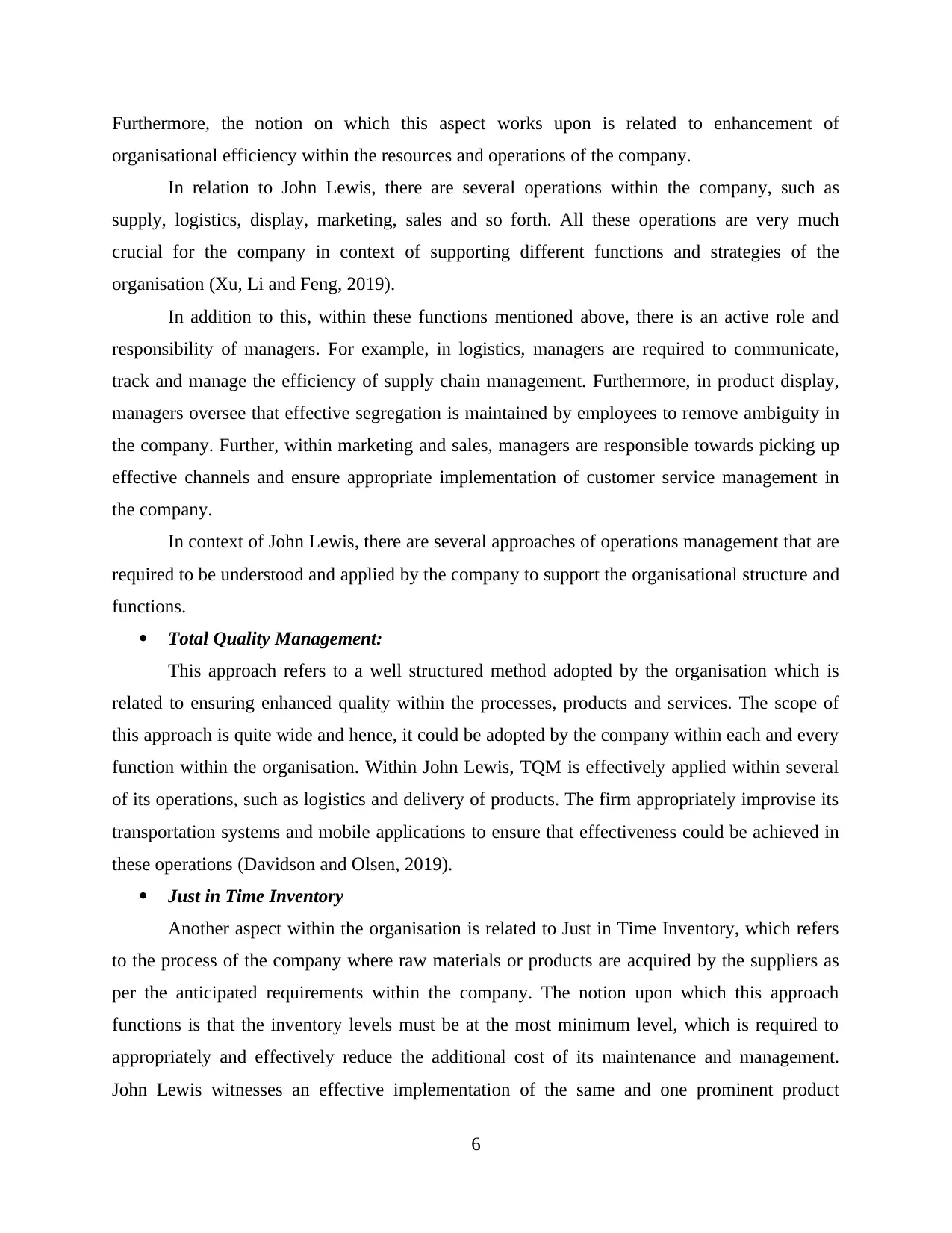
Furthermore, the notion on which this aspect works upon is related to enhancement of
organisational efficiency within the resources and operations of the company.
In relation to John Lewis, there are several operations within the company, such as
supply, logistics, display, marketing, sales and so forth. All these operations are very much
crucial for the company in context of supporting different functions and strategies of the
organisation (Xu, Li and Feng, 2019).
In addition to this, within these functions mentioned above, there is an active role and
responsibility of managers. For example, in logistics, managers are required to communicate,
track and manage the efficiency of supply chain management. Furthermore, in product display,
managers oversee that effective segregation is maintained by employees to remove ambiguity in
the company. Further, within marketing and sales, managers are responsible towards picking up
effective channels and ensure appropriate implementation of customer service management in
the company.
In context of John Lewis, there are several approaches of operations management that are
required to be understood and applied by the company to support the organisational structure and
functions.
Total Quality Management:
This approach refers to a well structured method adopted by the organisation which is
related to ensuring enhanced quality within the processes, products and services. The scope of
this approach is quite wide and hence, it could be adopted by the company within each and every
function within the organisation. Within John Lewis, TQM is effectively applied within several
of its operations, such as logistics and delivery of products. The firm appropriately improvise its
transportation systems and mobile applications to ensure that effectiveness could be achieved in
these operations (Davidson and Olsen, 2019).
Just in Time Inventory
Another aspect within the organisation is related to Just in Time Inventory, which refers
to the process of the company where raw materials or products are acquired by the suppliers as
per the anticipated requirements within the company. The notion upon which this approach
functions is that the inventory levels must be at the most minimum level, which is required to
appropriately and effectively reduce the additional cost of its maintenance and management.
John Lewis witnesses an effective implementation of the same and one prominent product
6
organisational efficiency within the resources and operations of the company.
In relation to John Lewis, there are several operations within the company, such as
supply, logistics, display, marketing, sales and so forth. All these operations are very much
crucial for the company in context of supporting different functions and strategies of the
organisation (Xu, Li and Feng, 2019).
In addition to this, within these functions mentioned above, there is an active role and
responsibility of managers. For example, in logistics, managers are required to communicate,
track and manage the efficiency of supply chain management. Furthermore, in product display,
managers oversee that effective segregation is maintained by employees to remove ambiguity in
the company. Further, within marketing and sales, managers are responsible towards picking up
effective channels and ensure appropriate implementation of customer service management in
the company.
In context of John Lewis, there are several approaches of operations management that are
required to be understood and applied by the company to support the organisational structure and
functions.
Total Quality Management:
This approach refers to a well structured method adopted by the organisation which is
related to ensuring enhanced quality within the processes, products and services. The scope of
this approach is quite wide and hence, it could be adopted by the company within each and every
function within the organisation. Within John Lewis, TQM is effectively applied within several
of its operations, such as logistics and delivery of products. The firm appropriately improvise its
transportation systems and mobile applications to ensure that effectiveness could be achieved in
these operations (Davidson and Olsen, 2019).
Just in Time Inventory
Another aspect within the organisation is related to Just in Time Inventory, which refers
to the process of the company where raw materials or products are acquired by the suppliers as
per the anticipated requirements within the company. The notion upon which this approach
functions is that the inventory levels must be at the most minimum level, which is required to
appropriately and effectively reduce the additional cost of its maintenance and management.
John Lewis witnesses an effective implementation of the same and one prominent product
6
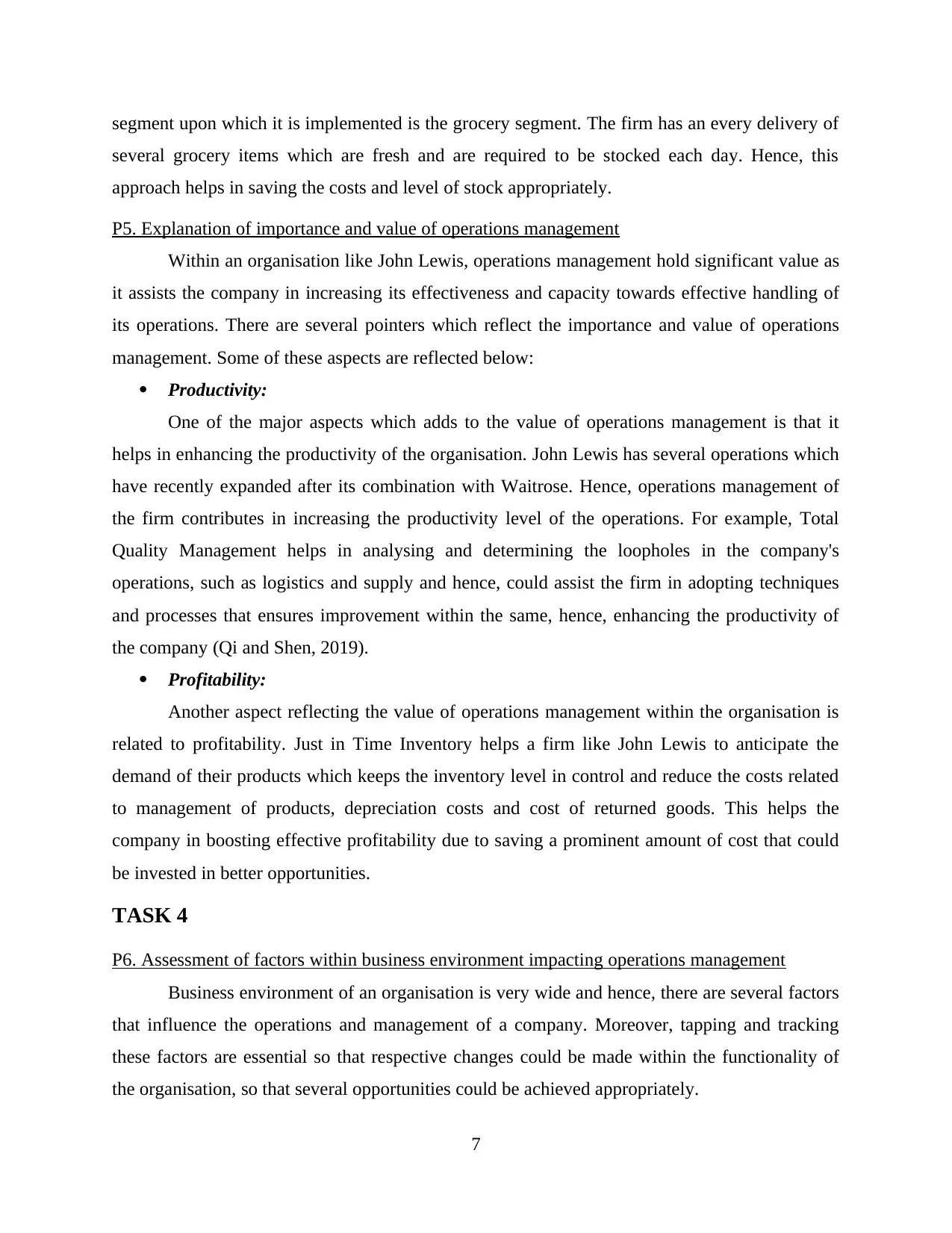
segment upon which it is implemented is the grocery segment. The firm has an every delivery of
several grocery items which are fresh and are required to be stocked each day. Hence, this
approach helps in saving the costs and level of stock appropriately.
P5. Explanation of importance and value of operations management
Within an organisation like John Lewis, operations management hold significant value as
it assists the company in increasing its effectiveness and capacity towards effective handling of
its operations. There are several pointers which reflect the importance and value of operations
management. Some of these aspects are reflected below:
Productivity:
One of the major aspects which adds to the value of operations management is that it
helps in enhancing the productivity of the organisation. John Lewis has several operations which
have recently expanded after its combination with Waitrose. Hence, operations management of
the firm contributes in increasing the productivity level of the operations. For example, Total
Quality Management helps in analysing and determining the loopholes in the company's
operations, such as logistics and supply and hence, could assist the firm in adopting techniques
and processes that ensures improvement within the same, hence, enhancing the productivity of
the company (Qi and Shen, 2019).
Profitability:
Another aspect reflecting the value of operations management within the organisation is
related to profitability. Just in Time Inventory helps a firm like John Lewis to anticipate the
demand of their products which keeps the inventory level in control and reduce the costs related
to management of products, depreciation costs and cost of returned goods. This helps the
company in boosting effective profitability due to saving a prominent amount of cost that could
be invested in better opportunities.
TASK 4
P6. Assessment of factors within business environment impacting operations management
Business environment of an organisation is very wide and hence, there are several factors
that influence the operations and management of a company. Moreover, tapping and tracking
these factors are essential so that respective changes could be made within the functionality of
the organisation, so that several opportunities could be achieved appropriately.
7
several grocery items which are fresh and are required to be stocked each day. Hence, this
approach helps in saving the costs and level of stock appropriately.
P5. Explanation of importance and value of operations management
Within an organisation like John Lewis, operations management hold significant value as
it assists the company in increasing its effectiveness and capacity towards effective handling of
its operations. There are several pointers which reflect the importance and value of operations
management. Some of these aspects are reflected below:
Productivity:
One of the major aspects which adds to the value of operations management is that it
helps in enhancing the productivity of the organisation. John Lewis has several operations which
have recently expanded after its combination with Waitrose. Hence, operations management of
the firm contributes in increasing the productivity level of the operations. For example, Total
Quality Management helps in analysing and determining the loopholes in the company's
operations, such as logistics and supply and hence, could assist the firm in adopting techniques
and processes that ensures improvement within the same, hence, enhancing the productivity of
the company (Qi and Shen, 2019).
Profitability:
Another aspect reflecting the value of operations management within the organisation is
related to profitability. Just in Time Inventory helps a firm like John Lewis to anticipate the
demand of their products which keeps the inventory level in control and reduce the costs related
to management of products, depreciation costs and cost of returned goods. This helps the
company in boosting effective profitability due to saving a prominent amount of cost that could
be invested in better opportunities.
TASK 4
P6. Assessment of factors within business environment impacting operations management
Business environment of an organisation is very wide and hence, there are several factors
that influence the operations and management of a company. Moreover, tapping and tracking
these factors are essential so that respective changes could be made within the functionality of
the organisation, so that several opportunities could be achieved appropriately.
7
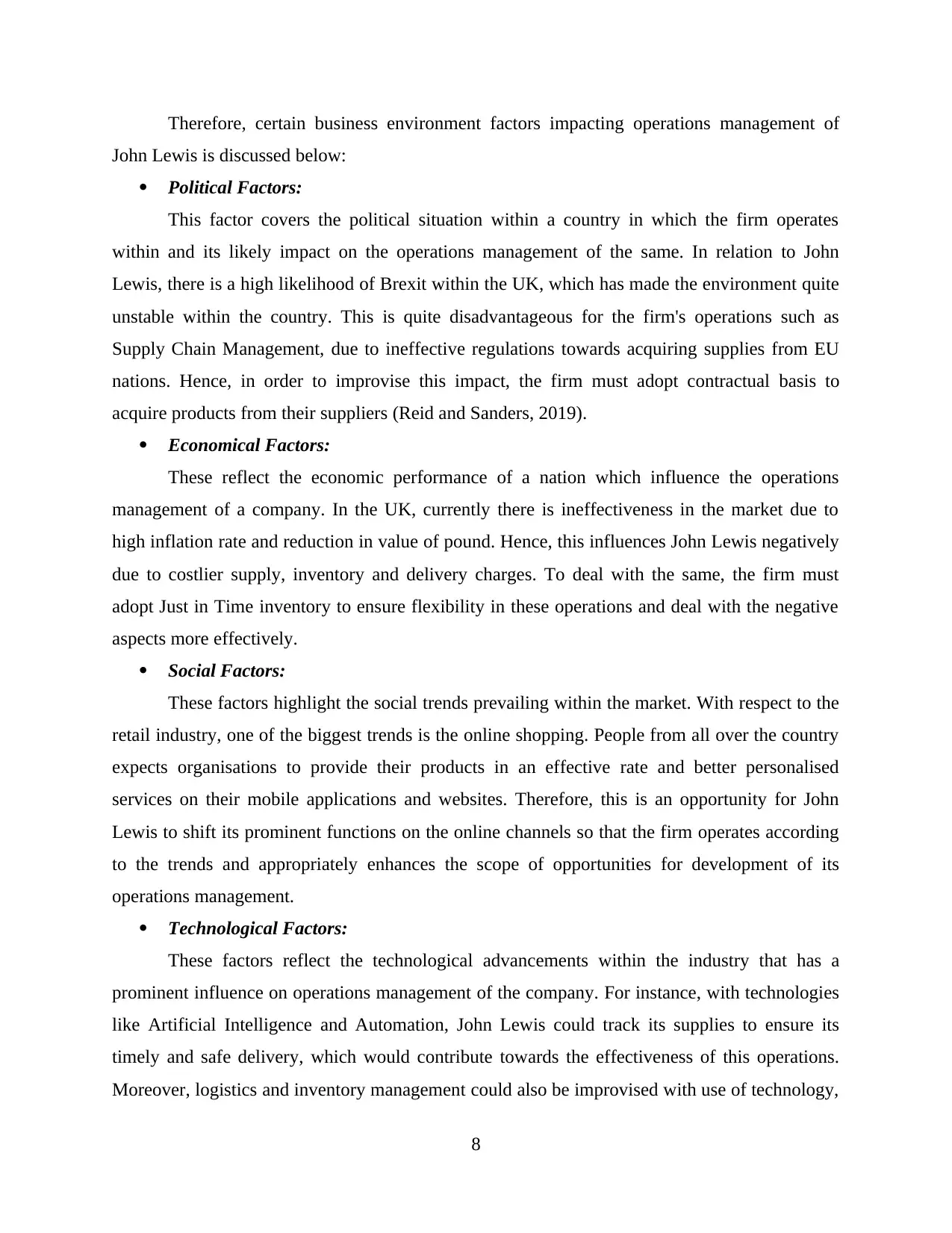
Therefore, certain business environment factors impacting operations management of
John Lewis is discussed below:
Political Factors:
This factor covers the political situation within a country in which the firm operates
within and its likely impact on the operations management of the same. In relation to John
Lewis, there is a high likelihood of Brexit within the UK, which has made the environment quite
unstable within the country. This is quite disadvantageous for the firm's operations such as
Supply Chain Management, due to ineffective regulations towards acquiring supplies from EU
nations. Hence, in order to improvise this impact, the firm must adopt contractual basis to
acquire products from their suppliers (Reid and Sanders, 2019).
Economical Factors:
These reflect the economic performance of a nation which influence the operations
management of a company. In the UK, currently there is ineffectiveness in the market due to
high inflation rate and reduction in value of pound. Hence, this influences John Lewis negatively
due to costlier supply, inventory and delivery charges. To deal with the same, the firm must
adopt Just in Time inventory to ensure flexibility in these operations and deal with the negative
aspects more effectively.
Social Factors:
These factors highlight the social trends prevailing within the market. With respect to the
retail industry, one of the biggest trends is the online shopping. People from all over the country
expects organisations to provide their products in an effective rate and better personalised
services on their mobile applications and websites. Therefore, this is an opportunity for John
Lewis to shift its prominent functions on the online channels so that the firm operates according
to the trends and appropriately enhances the scope of opportunities for development of its
operations management.
Technological Factors:
These factors reflect the technological advancements within the industry that has a
prominent influence on operations management of the company. For instance, with technologies
like Artificial Intelligence and Automation, John Lewis could track its supplies to ensure its
timely and safe delivery, which would contribute towards the effectiveness of this operations.
Moreover, logistics and inventory management could also be improvised with use of technology,
8
John Lewis is discussed below:
Political Factors:
This factor covers the political situation within a country in which the firm operates
within and its likely impact on the operations management of the same. In relation to John
Lewis, there is a high likelihood of Brexit within the UK, which has made the environment quite
unstable within the country. This is quite disadvantageous for the firm's operations such as
Supply Chain Management, due to ineffective regulations towards acquiring supplies from EU
nations. Hence, in order to improvise this impact, the firm must adopt contractual basis to
acquire products from their suppliers (Reid and Sanders, 2019).
Economical Factors:
These reflect the economic performance of a nation which influence the operations
management of a company. In the UK, currently there is ineffectiveness in the market due to
high inflation rate and reduction in value of pound. Hence, this influences John Lewis negatively
due to costlier supply, inventory and delivery charges. To deal with the same, the firm must
adopt Just in Time inventory to ensure flexibility in these operations and deal with the negative
aspects more effectively.
Social Factors:
These factors highlight the social trends prevailing within the market. With respect to the
retail industry, one of the biggest trends is the online shopping. People from all over the country
expects organisations to provide their products in an effective rate and better personalised
services on their mobile applications and websites. Therefore, this is an opportunity for John
Lewis to shift its prominent functions on the online channels so that the firm operates according
to the trends and appropriately enhances the scope of opportunities for development of its
operations management.
Technological Factors:
These factors reflect the technological advancements within the industry that has a
prominent influence on operations management of the company. For instance, with technologies
like Artificial Intelligence and Automation, John Lewis could track its supplies to ensure its
timely and safe delivery, which would contribute towards the effectiveness of this operations.
Moreover, logistics and inventory management could also be improvised with use of technology,
8
Secure Best Marks with AI Grader
Need help grading? Try our AI Grader for instant feedback on your assignments.
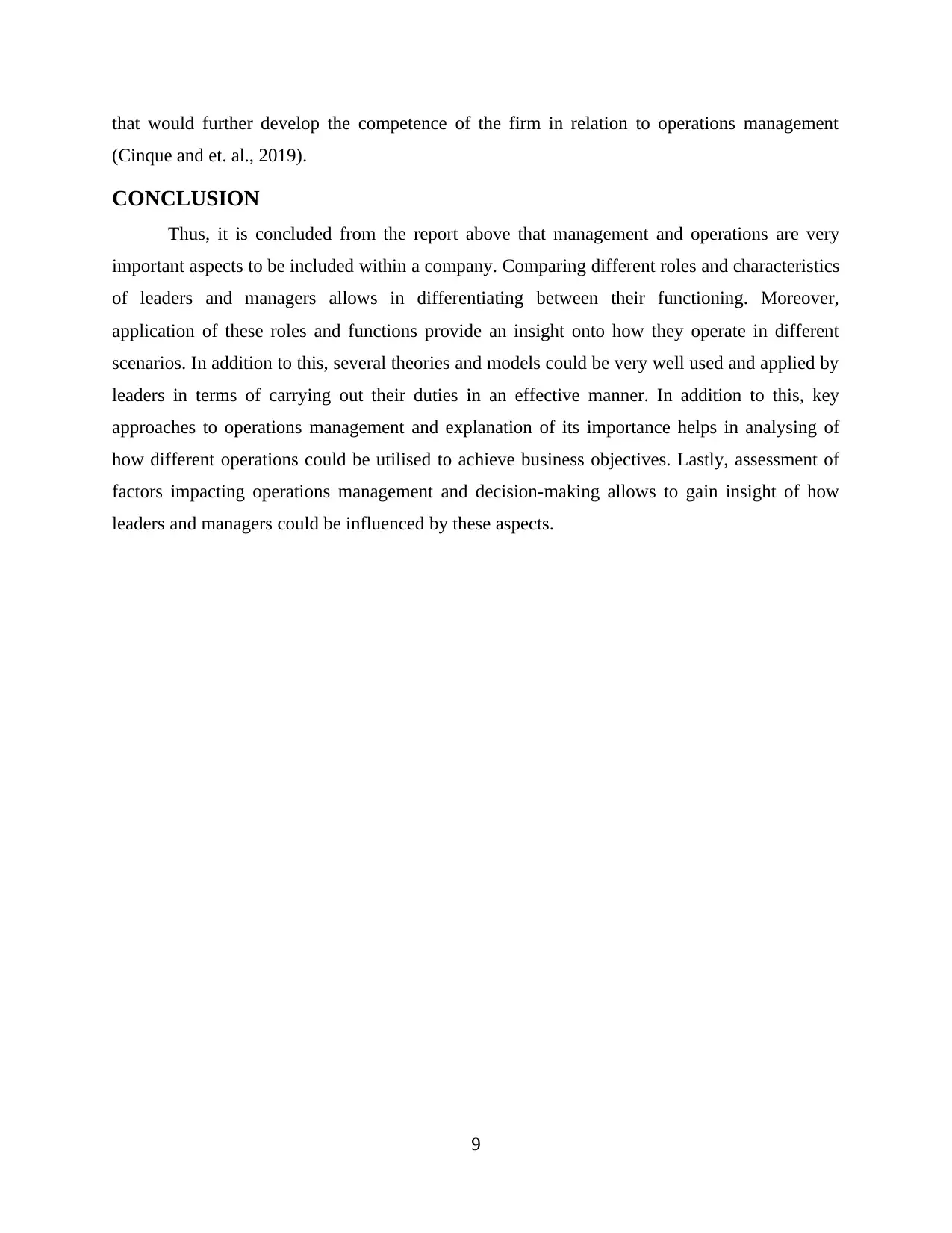
that would further develop the competence of the firm in relation to operations management
(Cinque and et. al., 2019).
CONCLUSION
Thus, it is concluded from the report above that management and operations are very
important aspects to be included within a company. Comparing different roles and characteristics
of leaders and managers allows in differentiating between their functioning. Moreover,
application of these roles and functions provide an insight onto how they operate in different
scenarios. In addition to this, several theories and models could be very well used and applied by
leaders in terms of carrying out their duties in an effective manner. In addition to this, key
approaches to operations management and explanation of its importance helps in analysing of
how different operations could be utilised to achieve business objectives. Lastly, assessment of
factors impacting operations management and decision-making allows to gain insight of how
leaders and managers could be influenced by these aspects.
9
(Cinque and et. al., 2019).
CONCLUSION
Thus, it is concluded from the report above that management and operations are very
important aspects to be included within a company. Comparing different roles and characteristics
of leaders and managers allows in differentiating between their functioning. Moreover,
application of these roles and functions provide an insight onto how they operate in different
scenarios. In addition to this, several theories and models could be very well used and applied by
leaders in terms of carrying out their duties in an effective manner. In addition to this, key
approaches to operations management and explanation of its importance helps in analysing of
how different operations could be utilised to achieve business objectives. Lastly, assessment of
factors impacting operations management and decision-making allows to gain insight of how
leaders and managers could be influenced by these aspects.
9
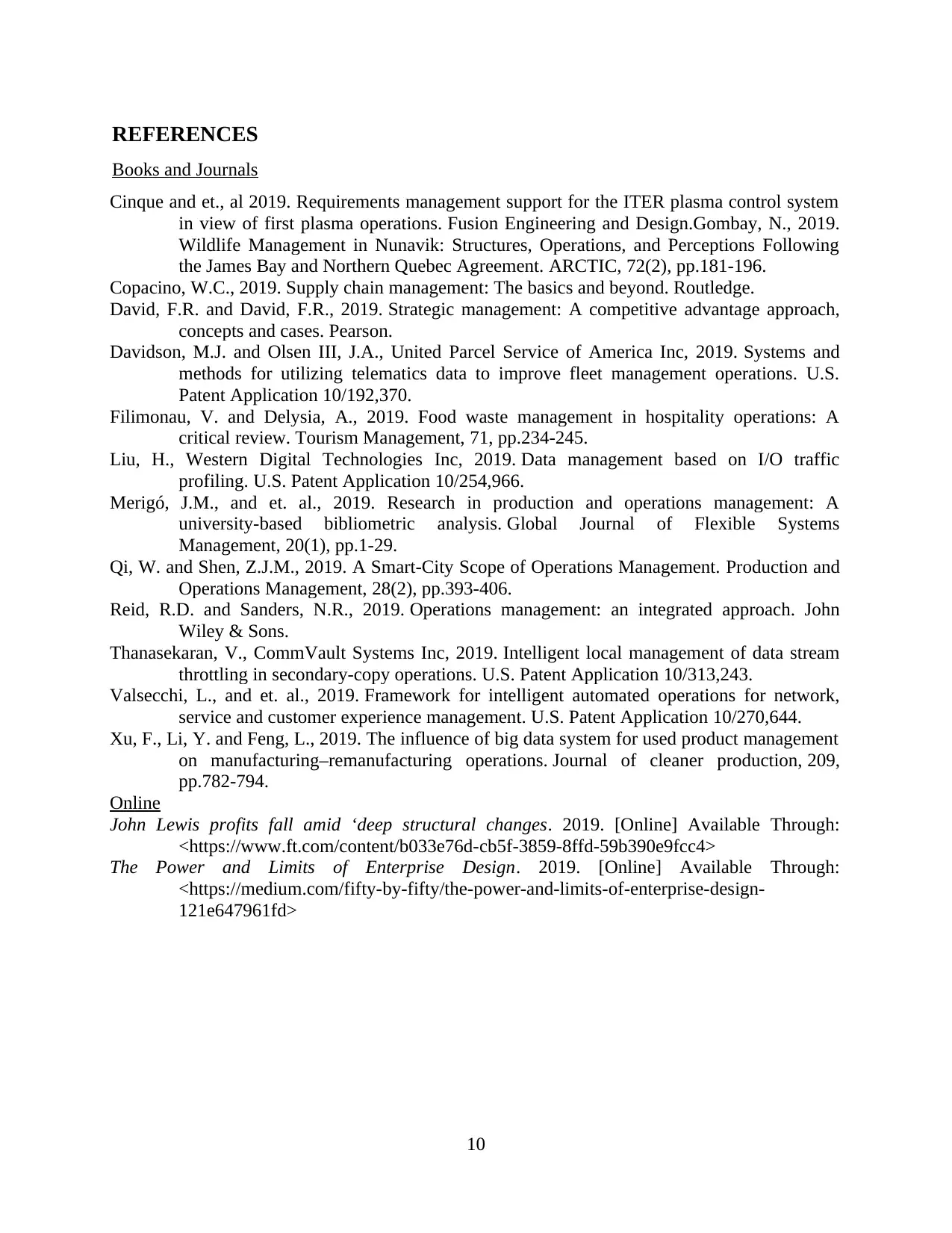
REFERENCES
Books and Journals
Cinque and et., al 2019. Requirements management support for the ITER plasma control system
in view of first plasma operations. Fusion Engineering and Design.Gombay, N., 2019.
Wildlife Management in Nunavik: Structures, Operations, and Perceptions Following
the James Bay and Northern Quebec Agreement. ARCTIC, 72(2), pp.181-196.
Copacino, W.C., 2019. Supply chain management: The basics and beyond. Routledge.
David, F.R. and David, F.R., 2019. Strategic management: A competitive advantage approach,
concepts and cases. Pearson.
Davidson, M.J. and Olsen III, J.A., United Parcel Service of America Inc, 2019. Systems and
methods for utilizing telematics data to improve fleet management operations. U.S.
Patent Application 10/192,370.
Filimonau, V. and Delysia, A., 2019. Food waste management in hospitality operations: A
critical review. Tourism Management, 71, pp.234-245.
Liu, H., Western Digital Technologies Inc, 2019. Data management based on I/O traffic
profiling. U.S. Patent Application 10/254,966.
Merigó, J.M., and et. al., 2019. Research in production and operations management: A
university-based bibliometric analysis. Global Journal of Flexible Systems
Management, 20(1), pp.1-29.
Qi, W. and Shen, Z.J.M., 2019. A Smart‐City Scope of Operations Management. Production and
Operations Management, 28(2), pp.393-406.
Reid, R.D. and Sanders, N.R., 2019. Operations management: an integrated approach. John
Wiley & Sons.
Thanasekaran, V., CommVault Systems Inc, 2019. Intelligent local management of data stream
throttling in secondary-copy operations. U.S. Patent Application 10/313,243.
Valsecchi, L., and et. al., 2019. Framework for intelligent automated operations for network,
service and customer experience management. U.S. Patent Application 10/270,644.
Xu, F., Li, Y. and Feng, L., 2019. The influence of big data system for used product management
on manufacturing–remanufacturing operations. Journal of cleaner production, 209,
pp.782-794.
Online
John Lewis profits fall amid ‘deep structural changes. 2019. [Online] Available Through:
<https://www.ft.com/content/b033e76d-cb5f-3859-8ffd-59b390e9fcc4>
The Power and Limits of Enterprise Design. 2019. [Online] Available Through:
<https://medium.com/fifty-by-fifty/the-power-and-limits-of-enterprise-design-
121e647961fd>
10
Books and Journals
Cinque and et., al 2019. Requirements management support for the ITER plasma control system
in view of first plasma operations. Fusion Engineering and Design.Gombay, N., 2019.
Wildlife Management in Nunavik: Structures, Operations, and Perceptions Following
the James Bay and Northern Quebec Agreement. ARCTIC, 72(2), pp.181-196.
Copacino, W.C., 2019. Supply chain management: The basics and beyond. Routledge.
David, F.R. and David, F.R., 2019. Strategic management: A competitive advantage approach,
concepts and cases. Pearson.
Davidson, M.J. and Olsen III, J.A., United Parcel Service of America Inc, 2019. Systems and
methods for utilizing telematics data to improve fleet management operations. U.S.
Patent Application 10/192,370.
Filimonau, V. and Delysia, A., 2019. Food waste management in hospitality operations: A
critical review. Tourism Management, 71, pp.234-245.
Liu, H., Western Digital Technologies Inc, 2019. Data management based on I/O traffic
profiling. U.S. Patent Application 10/254,966.
Merigó, J.M., and et. al., 2019. Research in production and operations management: A
university-based bibliometric analysis. Global Journal of Flexible Systems
Management, 20(1), pp.1-29.
Qi, W. and Shen, Z.J.M., 2019. A Smart‐City Scope of Operations Management. Production and
Operations Management, 28(2), pp.393-406.
Reid, R.D. and Sanders, N.R., 2019. Operations management: an integrated approach. John
Wiley & Sons.
Thanasekaran, V., CommVault Systems Inc, 2019. Intelligent local management of data stream
throttling in secondary-copy operations. U.S. Patent Application 10/313,243.
Valsecchi, L., and et. al., 2019. Framework for intelligent automated operations for network,
service and customer experience management. U.S. Patent Application 10/270,644.
Xu, F., Li, Y. and Feng, L., 2019. The influence of big data system for used product management
on manufacturing–remanufacturing operations. Journal of cleaner production, 209,
pp.782-794.
Online
John Lewis profits fall amid ‘deep structural changes. 2019. [Online] Available Through:
<https://www.ft.com/content/b033e76d-cb5f-3859-8ffd-59b390e9fcc4>
The Power and Limits of Enterprise Design. 2019. [Online] Available Through:
<https://medium.com/fifty-by-fifty/the-power-and-limits-of-enterprise-design-
121e647961fd>
10
1 out of 12
Related Documents
Your All-in-One AI-Powered Toolkit for Academic Success.
+13062052269
info@desklib.com
Available 24*7 on WhatsApp / Email
![[object Object]](/_next/static/media/star-bottom.7253800d.svg)
Unlock your academic potential
© 2024 | Zucol Services PVT LTD | All rights reserved.





